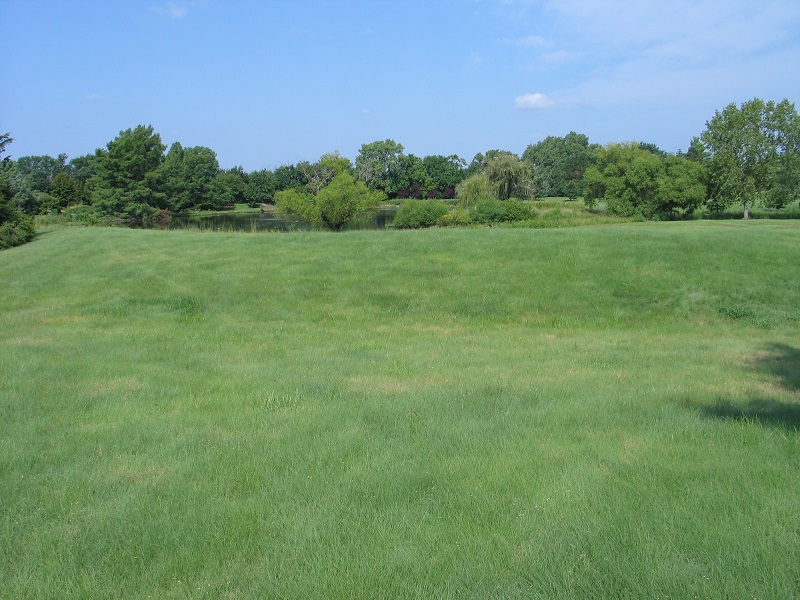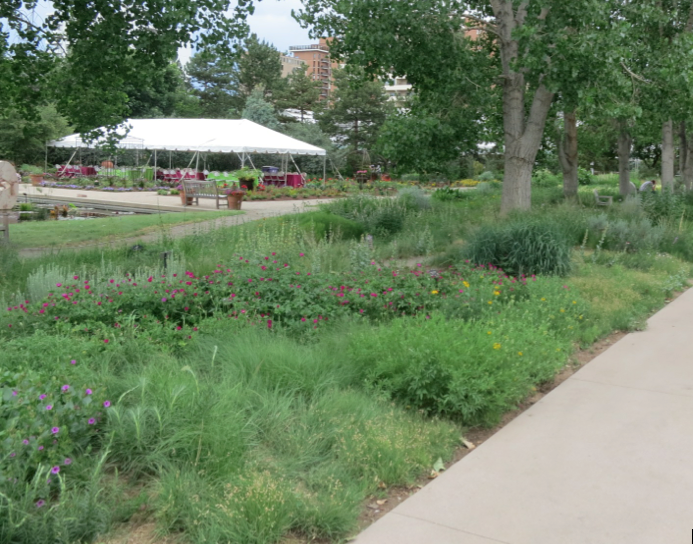There has been recent renewed interest in establishing buffalograss lawn areas as an alternative to conventional fescue. Buffalograss is a native sod-forming grass species that is well adapted to our climate. It is a nice choice for open, sunny areas. As a warm season grass, it uses water efficiently and effectively, even during periodic and prolonged droughts. This fine textured prairie grass spreads by both seed and stolons (runners), which take root and produce new plants. We have buffalograss varieties of Cody, Sundancer, Legacy and Bowie growing on the Dyck Arboretum grounds.

Weeds
One of the drawbacks of buffalograss is that it susceptible to weed infestations. Crabgrass and foxtail are problematic summer annual weeds and henbit, dandelion and chickweed are broadleaf weeds that regularly infiltrate buffalograss. Each of these types of weeds requires monitoring and sometimes control measures.
Timing
Usually in late October to early November, we spray for broadleaf weeds in our buffalograss lawn areas. We have several acres of buffalograss, so we hire someone to spray for us. Choose a day that is 50 degrees or higher. The better the weed is growing, the more weed killer will be moved from the leaves to the roots. Cold temperatures will slow this process, but these products will still work at lower temperatures.
Weed Control
Here at the Arboretum, we are seeing henbit germinate and dandelions greening back up due to earlier rains and cooler temperatures. These perennial and winter annual weeds usually have germinated by October, but they may be later this year due to the lack of moisture. However, we are seeing some winter annual weeds.
It is best to control these young plants when they are small before they get fully established. We use herbicides such as 2,4-D or Trimec blends with 2,4-D, MCPP and Dicamba. By spraying now, these weeds uptake the chemicals and move it from the leaves to the roots readily. This process of translocation is naturally occurring with most plants resulting in a more complete kill of the plant including the roots.

Pre-emergent Weed Control
One of the practices we have tried on smaller areas of buffalograss is the use of pre-emergent herbicides in the spring. This is primarily to control summer annuals such as crabgrass and foxtail. Barricade (prodiamine), Pendulum Aquacap (pendimethalin), Dimension (dithiopyr), Specticle (indaziflam) are recommended pre-emergent herbicides on established Buffalograss stands. Read and follow the chemical label application instructions for best results. Pre-emergent herbicides can also be applied in the fall to control that pesky weed, little barley.
Is all this worth it?
We encourage people to use buffalograss despite having to spray it occasionally. Newer varieties are vigorous growers and require little to no water once established. Compare that to a traditional fescue lawn, which needs one to two inches of moisture per week to keep it alive in the summer. These newer buffalograss forms stay green longer in the fall and green up earlier in the spring. If kept relatively weed free, they require less frequent mowing. Buffalograss need little to no fertilizer and overall will reduce your maintenance.
It is not my favorite thing to do, but we have seen real benefits from these regular spraying and pre-emergent applications. Before we sprayed in the fall, we were mostly mowing weeds the next spring, especially henbit. In early spring, the henbit was flourishing, but the buffalograss had not started actively growing. Dandelion, chickweed, and bindweed also had free reign. We made the decision to spray in the fall and it has made such a difference the next year.
By the way, it’s not too late to prepare your landscape for a buffalograss lawn planting next year.
